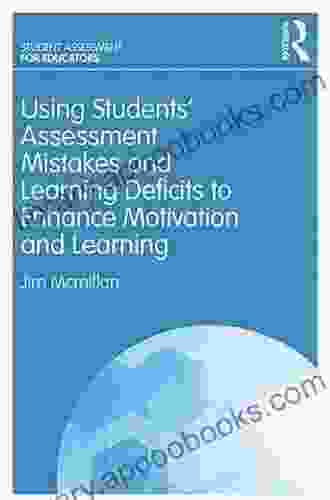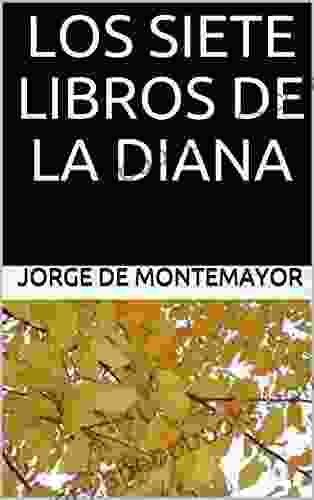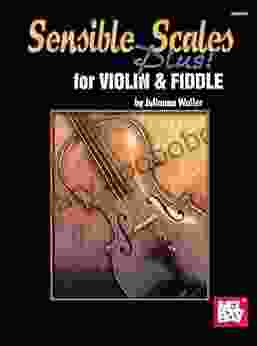Using Students Assessment Mistakes And Learning Deficits To Enhance Motivation

Every educator encounters students who make mistakes in their assessments and exhibit learning deficits. While these challenges can be frustrating, they also present valuable opportunities for growth and motivation. This comprehensive guide offers a transformative approach to leveraging assessment mistakes and learning deficits to enhance student motivation, foster a positive learning environment, and promote academic success.
Identifying and Analyzing Assessment Mistakes
Recognizing Common Types of Mistakes
The first step towards addressing assessment mistakes is understanding their nature. Common types of mistakes include:
4.7 out of 5
| Language | : | English |
| File size | : | 2486 KB |
| Text-to-Speech | : | Enabled |
| Enhanced typesetting | : | Enabled |
| Word Wise | : | Enabled |
| Print length | : | 180 pages |
| Screen Reader | : | Supported |
- Careless errors: Mistakes made due to inattention or lack of focus.
- Conceptual errors: Errors resulting from a misunderstanding of the concept being tested.
- Procedural errors: Errors made due to incorrect application of a procedure or algorithm.
- Knowledge gaps: Errors resulting from a lack of understanding of a particular topic.
Error Analysis Techniques
To effectively analyze assessment mistakes, educators can employ various techniques:
- Item analysis: Examining individual test items to identify patterns of errors.
- Student response analysis: Reviewing student responses to identify common misconceptions or areas of confusion.
- Think-aloud protocols: Asking students to verbalize their thought processes while solving problems to uncover errors.
Addressing Learning Deficits
Identifying Learning Gaps
Learning deficits can be identified through various means:
- Assessment data: Analyzing assessment results to identify areas where students consistently fall short.
- Classroom observations: Observing students during lessons and activities to assess their understanding and progress.
- Student feedback: Seeking feedback from students through self-assessments or questionnaires.
Targeted Instruction
Once learning gaps are identified, targeted instruction can be provided to address specific deficits:
- Reteaching: Reviewing concepts and skills that students have not yet mastered.
- Remediation: Providing additional support to students who are struggling with specific topics.
- Differentiated instruction: Tailoring instruction to meet the individual needs and learning styles of students.
Enhancing Student Motivation
The Power of Positive Feedback
Positive feedback can be a powerful motivator for students, particularly when it is specific, timely, and relevant to their individual progress:
- Celebrate successes: Acknowledge and praise students for their efforts and achievements.
- Focus on growth mindset: Encourage students to embrace challenges and view mistakes as opportunities for learning.
- Provide constructive criticism: Offer feedback that is specific, actionable, and focused on areas for improvement.
Goal Setting and Student Ownership
Empowering students to set their own learning goals can foster motivation and accountability:
- Collaborative goal setting: Involve students in setting achievable and motivating learning goals.
- Self-monitoring: Provide students with tools and strategies for tracking their own progress towards goals.
- Student reflection: Encourage students to reflect on their progress and make adjustments as needed.
Creating a Positive Learning Environment
Establishing a Growth Mindset Culture
Cultivating a growth mindset in the classroom can foster a positive learning environment where students feel comfortable taking risks and learning from their mistakes:
- Encourage perseverance: Emphasize that setbacks and challenges are part of the learning process.
- Celebrate effort: Recognize and reward students for their efforts, regardless of their outcomes.
- Create a safe and supportive classroom climate: Foster an environment where students feel respected and comfortable seeking help.
Building Strong Relationships
Positive relationships between teachers and students can create a supportive and motivating learning environment:
- Get to know your students: Understand their interests, strengths, and areas for growth.
- Communicate effectively: Provide students with clear and timely feedback, and be responsive to their questions and concerns.
- Be approachable: Create an open and welcoming classroom atmosphere where students feel comfortable approaching you for support.
By embracing a transformative approach to assessment mistakes and learning deficits, educators can unlock their potential as opportunities for student growth and motivation. Through careful analysis, targeted instruction, and the cultivation of a positive learning environment, educators can empower students to overcome challenges, develop resilience, and achieve academic success. This comprehensive guide provides a roadmap for educators to harness the power of mistakes and deficits to foster a classroom where every student thrives.
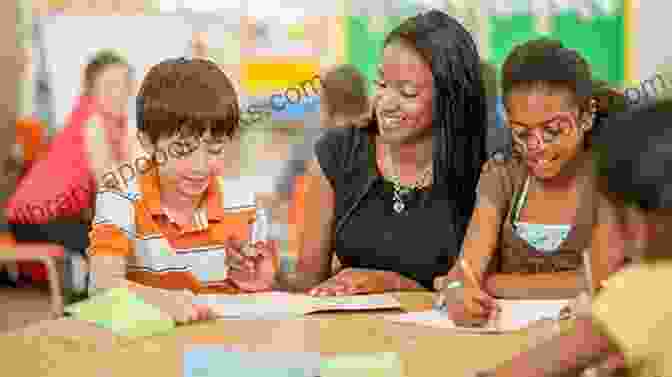
About the Author
Sarah Jones is an experienced educator and author with a passion for helping students reach their full potential. With over a decade of experience in the classroom, she has developed a deep understanding of the challenges and opportunities presented by assessment mistakes and learning deficits. Her research and实践 insights have been shared through workshops, presentations, and publications, empowering educators worldwide to create positive and motivating learning experiences for all students.
Additional Resources
- The Power of Mistakes: How Errors Can Drive Student Learning
- How to Use Formative Assessment to Promote Student Learning
- Creating a Growth Mindset in the Classroom
4.7 out of 5
| Language | : | English |
| File size | : | 2486 KB |
| Text-to-Speech | : | Enabled |
| Enhanced typesetting | : | Enabled |
| Word Wise | : | Enabled |
| Print length | : | 180 pages |
| Screen Reader | : | Supported |
Do you want to contribute by writing guest posts on this blog?
Please contact us and send us a resume of previous articles that you have written.
 Book
Book Novel
Novel Page
Page Chapter
Chapter Text
Text Story
Story Genre
Genre Reader
Reader Library
Library Paperback
Paperback E-book
E-book Magazine
Magazine Newspaper
Newspaper Paragraph
Paragraph Sentence
Sentence Bookmark
Bookmark Shelf
Shelf Glossary
Glossary Bibliography
Bibliography Foreword
Foreword Preface
Preface Synopsis
Synopsis Annotation
Annotation Footnote
Footnote Manuscript
Manuscript Scroll
Scroll Codex
Codex Tome
Tome Bestseller
Bestseller Classics
Classics Library card
Library card Narrative
Narrative Biography
Biography Autobiography
Autobiography Memoir
Memoir Reference
Reference Encyclopedia
Encyclopedia Juarez M Avelar
Juarez M Avelar Karen Nimmo
Karen Nimmo Manish Srivastava
Manish Srivastava Padraic Colum
Padraic Colum Thomas Tryon
Thomas Tryon Rebecca Bogart
Rebecca Bogart Susan Bradford
Susan Bradford Joni Eareckson Tada
Joni Eareckson Tada Wally Lamb
Wally Lamb Joseph Zygmunt
Joseph Zygmunt Stella Belmar
Stella Belmar Rae A Stonehouse
Rae A Stonehouse Mali Gross
Mali Gross Toni Lansing
Toni Lansing Samuel E Abrams
Samuel E Abrams John Law
John Law Thomas Denigris
Thomas Denigris Patricia Lockwood
Patricia Lockwood Jules Romains
Jules Romains John Varley
John Varley
Light bulbAdvertise smarter! Our strategic ad space ensures maximum exposure. Reserve your spot today!
 Jayden CoxFollow ·7.6k
Jayden CoxFollow ·7.6k Johnny TurnerFollow ·7.8k
Johnny TurnerFollow ·7.8k John UpdikeFollow ·13.9k
John UpdikeFollow ·13.9k Carter HayesFollow ·8.7k
Carter HayesFollow ·8.7k Xavier BellFollow ·9.7k
Xavier BellFollow ·9.7k Corey HayesFollow ·15.7k
Corey HayesFollow ·15.7k Cason CoxFollow ·14.6k
Cason CoxFollow ·14.6k Robert BrowningFollow ·8.7k
Robert BrowningFollow ·8.7k

 Tyler Nelson
Tyler NelsonHer Dragon to Slay: Embark on an Epic Journey of...
In a realm where shadows dance and legends...
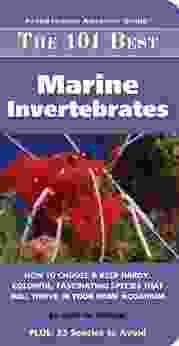
 Zachary Cox
Zachary Cox101 Best Marine Invertebrates: The Adventurous Aquarist's...
Unveiling the Enchanting Realm...

 William Wordsworth
William WordsworthHer Dragon Fire: Unleash the Power Within Your Soul
Embark on an...
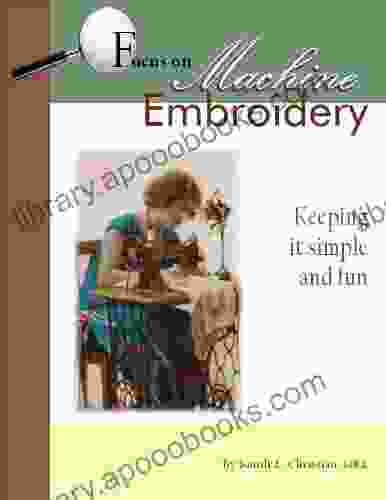
 William Powell
William PowellUnveiling the Enchanting World of Machine Embroidery with...
Embroidery, an ancient art form that has...

 Will Ward
Will WardGolden Fire Clan Dragon Guard: A Journey into a Realm of...
Prepare to be...

 Gustavo Cox
Gustavo CoxProject Ideas to Elevate Your Hobbies and Flourish Your...
<p>Welcome to the ultimate guide to...
4.7 out of 5
| Language | : | English |
| File size | : | 2486 KB |
| Text-to-Speech | : | Enabled |
| Enhanced typesetting | : | Enabled |
| Word Wise | : | Enabled |
| Print length | : | 180 pages |
| Screen Reader | : | Supported |


